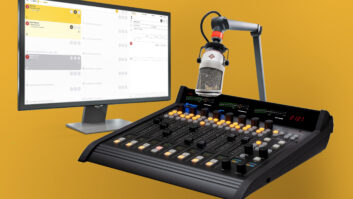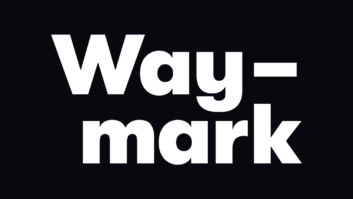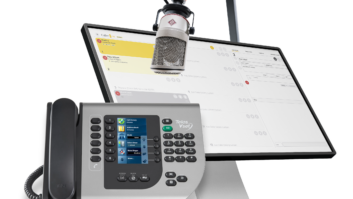Broadcasting radio remotes is a challenge. Over the past few years that task has become a bit more difficult with the advent of HD Radio and the resultant delays to be worked around.
Now, a new satellite service and an existing one with more options open new opportunities for broadcast remotes.
Recently EVDO Cards offered by various cellular companies have provided a way to connect wirelessly to the Internet, using data rates approaching a few hundred kilobits per second. The problems are that you have to be in an area where the cellular service is available; and the data rates vary widely depending on the provider, time of day and location, often leading to dropouts and long delay times sometimes exceeding 10 seconds or more.
Using a hard-wired Internet connection from a location that has wide bandwidth and an open firewall has turned out to be a good alternative; but even this requires careful planning and a thorough checkout days before the broadcast.
A new satellite service recently has become available to broadcasters in North America from Inmarsat, opening up interesting opportunities for both radio and television broadcasters.
The challenge
Greater Media owns five commercial Class B FM radio stations in the Boston market. As director of technical operations for the Boston Group, I am responsible for making sure that remote broadcasts get done successfully.
With five FM stations the remote schedule can get quite busy, particularly at certain times of the year. Programmers, especially those in the news business, are demanding high-quality remotes, often on short notice, and in some cases in areas where telephone facilities or line-of-sight RPU signals are nonexistent.
Looking for alternatives, I purchased an IP codec along with a portable satellite terminal to allow me to get the data back to the studio via satellite and the Internet. The satellite terminal was portable, about the size of a laptop, and was easy and quick to set up and align.
Data rates available on the hardware I used ranged up to 256 kilobits per second. Latency times including the coding, decoding, uplink, downlink and Internet transit time together totaled about one second. While certainly not optimal, it was workable for two-way communications.
(click thumbnail)Up in the sky
Inmarsat owns and operates a network of three communications satellites that form the Broadband Global Area Network service. BGAN offers connectivity to the Internet, POTS lines and the global ISDN network.
One of the advantages of deploying this technology for broadcasters is that BGAN is available just about anywhere, and connection to it requires no planning or advance notice once the user is registered as a subscriber to the service. Depending on the location, satellite look angles can vary quite a bit, but from most locations in North America, look angles are high, giving more flexibility to choosing a location without fear of terrain, buildings or trees being in the way.
The birds
The Inmarsat satellites are positioned in geostationary orbit. They follow a circular orbit in the plane of the equator at a height of 35,600 km, so they appear stationary relative to a point on the earth’s surface.
They are controlled from the Satellite Control Center at Inmarsat HQ in London, which is responsible for keeping the satellites in position and ensuring the onboard systems are functional.
A call from an Inmarsat mobile terminal goes directly to the satellite overhead, and is routed back to a gateway on the ground called a land earth station. From there the call is passed into the public phone network or the Internet. Eighty-five percent of the world’s land mass is illuminated by the Inmarsat footprints.
Although Inmarsat owns and operates the satellites, distribution partners and service providers supply the value-added connections of the service and the circuit once the transmission hits the ground.
Hardware options
In order to participate in this technology, the hardware on the user end required is usually purchased and the airtime plan is selected. Once registered with the service provider, the system can be used at any time without prior coordination.
Several hardware manufacturers offer options for ground-based terminals. Your selection will depend on several factors including size and portability, durability, ease of setup, maximum data rates desired and price.
Some available terminals are not much larger than a paperback book, and others are as large as a larger laptop computer.
One unit that I decided to gain some experience with is the Thrane & Thrane Explorer Model 700. This particular terminal fit my needs for radio remote broadcasts due to its light weight, ease of setup and high-speed data streaming capabilities.
This model has some attractive features including a rechargeable built-in battery, detachable uplink/downlink panel antenna, POTS phone line capability, ISDN capability and guaranteed data streaming capabilities up to 256 kbps. In addition, the unit can access the Internet at speeds of up to 492 kbps.
Data service options
The core of the BGAN service is IP data connections provided as on-demand streaming or standard IP connections. Streaming services are provided with guaranteed data rates over the satellite of 32, 64, 128 or 256 kbps. Streaming transmissions over the satellite are prioritized requests and are billed by the minute.
Standard IP transmissions can be as high as 492 kbps, but utilize a shared channel that can be dynamically reduced based on the number of users in the particular spot beam of the satellite. Standard IP is billed by the kb for all data transmitted to or from the terminal. Other service options are 64 kbps ISDN, 32 kbps, 64 kbps streaming and POTS voice that are also billed by the minute.
To establish a link to the network, the earth terminal is powered up either by battery or by the included AC power adapter. After a short boot time, the panel antenna can be oriented to look to the sky — generally to the equator — and the azimuth and elevation can be adjusted by hand to maximize the signal strength as indicated on the LCD display on the terminal.
The signal strength is also referenced by an audible tone that changes in pitch in proportion to the quality of the signal. After a short delay, the unit will register with the service provider and a ready indication will appear on the terminal’s display.
At this point, you may issue a command to initiate a streaming data connection to the Internet, or place a voice or an ISDN telephone call at 64 kbps. An IP address will be assigned for background IP Internet browsing.
While registering and aligning the terminal will not incur any charges to your account, the moment you initiate a streaming IP connection, the clock starts running and per minute data usage charges will accumulate even if you are not “using” the connection for meaningful audio transfer.
Operating costs
The cost of acquiring the hardware (satellite terminal) can range from about $2,000 to $4,000 depending on the type of equipment desired. The streaming data costs at 32 kbps are running about $2.40 per minute and 64 kilobit ISDN rates are near $5 per minute.
For example, a four-hour remote using 32 kilobits streaming will incur about $576 in satellite time. When this amount is compared to the cost paid to the phone company for the installation and usage charge for a land-line ISDN, the pricing seems to be more competitive. The flexibility and reliability of the satellite service can outweigh the cost if the broadcasts are critical and other options are not available.
Remote control
Since costs can add up fairly quickly for the streaming option of broadcasting, it may be desirable to have an easy way to start and stop the streaming process during certain types of remotes.
For example if a station is just doing “drop-ins” twice an hour, there may be no need to keep the stream running during the entire remote. By supplying a switch closure to the auxiliary port of the satellite terminal you may be able to more conveniently start and stop the streaming process just before and after the talent needs it, thus saving a significant amount of money.
No laptop
One of the concerns I had before deploying this technology was the simplicity of setting up and operating the equipment.
This is one reason I selected a terminal that can be pre-configured with a standard set of parameters; this allows the unit to be used in the field immediately after boot-up, without the need to bring along a laptop computer and a person who can configure the terminal. Not all terminals offer this feature.
Handling the delay
The subject of delay comes up more often these days. We know from working with new digital audio processing, compression and transport that listening off the air or even to a mix-minus from the studio can be a big problem. Any time the delay exceeds 15 to 20 milliseconds, a feed of the talent’s voice back into his or her headphones can be distracting or confusing.
Therefore a mix-minus feed containing not only the programming from the studio without the remote audio, but also a mix of the local remote audio must be fed to the talent’s earphones at the remote site.
VSAT
Another option for remote communications, Very Small Aperture Terminal communications satellites, has been around for decades. Today most are Ku band (12–14 GHz) used for, among other things, corporate communications and high-speed Internet access.
Many companies offer relatively inexpensive 1.2 meter “flyaway” systems that can be used for remotes. While not as convenient, or as inexpensive at the outset to purchase the hardware for, these systems offer reliable service and upload and download speeds that exceed those of the BGAN network.
The monthly rates for unlimited data transfer can be in the price range of what may be spent on only one or two remotes using the BGAN technology. Although I have not had any experience with these terminals for portable remotes, Greater Media has used them successfully for dedicated point-to-point links to carry program material continuously across the continent at reasonable rates.
The idea of using portable satellite terminals for remote broadcasts has finally come of age. Being able to get on the air instantly from just about anywhere on the globe with broadcast-quality audio is an attractive option that has not been available to broadcasters until now.
While the operating costs are still a bit high, having the hardware on hand along with an active data account allows a good measure of insurance for radio stations in case the primary method of broadcasting does not work or there is just no other way of doing the broadcast.
This article is excerpted from a paper published by the NAB Broadcast Engineering Conference.













